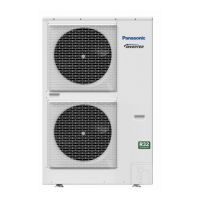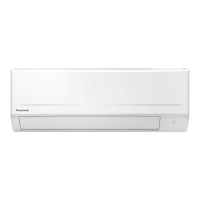1-12-2-1-15
1
IMPORTANT INFORMATION REGARDING THE REFRIGERANT USED
NOTE
See “■ Outdoor Unit” under the Section 1-12. Installation Instructions.
SERVICING
CAUTION
morf etac fiitrec dilav tnerruc a dloh dluohs tiucric tnaregirfer a otni gnikaerb ro no gnikrow htiw devlovni si ohw nosrep de fiilauq ynA
an industry-accredited assessment authority, which authorizes their competence to handle refrigerants safely in accordance with an
industry recognised assessment specifi cation.
-sissa eht gniriuqer riaper dna ecnanetniaM .rerutcafunam tnempiuqe eht yb dednemmocer sa demrofrep eb ylno llahs gnicivreS
tance of other skilled personnel shall be carried out under the supervision of the person competent in the use of fl ammable refriger-
ants.
.rerutcafunam eht yb dednemmocer sa ylno demrofrep eb llahs gnicivreS
noitingi fo ksir eht taht erusne
ot yrassecen era skcehc ytefas ,stnaregirfer elbamma fl gniniatnoc smetsys no krow gninnigeb ot roirP
is minimised. For repair to the refrigerating system, (2) to (6) shall be completed prior to conducting work on the system.
(1) Work shall be undertaken under a controlled procedure so as to minimise the risk of a fl ammable gas or vapour being present while
the work is being performed.
(2) All maintenance staff and others working in the local area shall be instructed on the nature of work being carried out. Work in
confi ned spaces shall be avoided. The area around the workspace shall be sectioned off. Ensure that the conditions within the area
have been made safe by control of fl ammable material.
(3) The area shall be checked with an appropriate refrigerant detector prior to and during work, to ensure the technician is aware
of potentially toxic or fl ammable atmospheres. Ensure that the leak detection equipment being used is suitable for use with all
applicable refrigerants, i.e. non-sparking, adequately sealed or intrinsically safe.
(4) If any hot work is to be conducted on the refrigeration equipment or any associated parts, appropriate fi re extinguishing equipment
shall be available to hand. Have a dry powder or CO
2
fi re extinguisher adjacent to the charging area.
(5) No person carrying out work in relation to a refrigeration system which involves exposing any pipe work shall use any sources of
ignition in such a manner that it may lead to the risk of fi re or explosion. All possible ignition sources, including cigarette smoking,
should be kept suffi ciently far away from the site of installation, repairing, removing and disposal, during which refrigerant can
possibly be released to the surrounding space. Prior to work taking place, the area around the equipment is to be surveyed to make
sure that there are no fl ammab
le hazards or ignition risks. “No Smoking” signs shall be displayed.
(6) Ensure that the area is in the open or that it is adequately ventilated before breaking into the system or conducting any hot work.
A degree of ventilation shall continue during the period that the work is carried out. The ventilation should safely disperse any
released refrigerant and preferably expel it externally into the atmosphere.
(7) Where electrical components are being changed, they shall be fi t for the purpose and to the correct specifi cation. At all times the
manufacturer’s maintenance and service guidelines shall be followed. If in doubt, consult the manufacturer’s technical department
for assistance.
• .dellatsni era strap gniniatnoc tnaregirfer eht hcihw nihtiw ezis moor eht htiw ecnadrocca ni si ezis egrahc ehT
• .detcurtsbo ton era dna yletauqeda gnitarepo era steltuo dna yrenihcam noitalitnev ehT
• .detcerroc eb llahs elbigelli era taht sngis dna sgnikraM .elbigel dna elbisiv eb ot seunitnoc tnempiuqe eht ot gnikraM
• yam hcihw ecnatsbus yna ot desopxe eb ot ylekilnu era yeht erehw noitisop a ni dellatsni era stnenopmoc ro epip noitaregirfeR
corrode refrigerant containing components, unless the components are constructed of materials which are inherently resistant to
being corroded or are suitably protected against being so corroded.
(8) Repair and maintenance to electrical components shall include initial safety checks and component inspection procedures. If a fault
exists that could compromise safety, then no electrical supply shall be connected to the circuit until it is satisfactorily dealt with. If
the fault cannot be corrected immediately but it is necessary to continue operation, an adequate temporary solution shall be used.
This shall be reported to the owner of the equipment so all parties are advised.
Initial safety checks shall include:
•
• That capacitors are discharged. This shall be done in a safe manner to avoid possibility of sparking.
.metsys eht gnigrup ro gnirevocer ,gnigrahc elihw desopxe era gniriw dna stnenopmoc lacirtcele evil on tahT
• .gnidnob htrae fo ytiunitnoc si ereht tahT
ot roirp nopu dekrow gnieb tnempiuqe eht morf detcennocsid eb llahs seilppus lacirtcele lla ,stnenopmoc delaes ot sriaper gniruD
any removal of sealed covers, etc.
ni deretla ton si gnisac eht ,stnenopmoc lacirtc
ele no gnikrow yb taht erusne ot gniwollof eht ot diap eb llahs noitnetta ralucitraP
such a way that the level of protection is affected. This shall include damage to cables, excessive number of connections, terminals
not made to original specifi cation, damage to seals, incorrect fi tting of glands, etc.
.yleruces detnuom si sutarappa taht erusnE
fo ssergni eht gnitneverp fo esoprup eht evres regnol on yeht taht hcus dedarged ton evah slairetam gnilaes ro slaes taht erusnE
fl ammable atmospheres.
.snoitac fiiceps s’rerutcafunam eht htiw ecnadrocca ni eb llahs strap tnemecalpeR
NOTE:
The use of silicon sealant may inhibit the effectiveness of some types of leak detection equipment. Intrinsically safe components do
not have to be isolated prior to working on them.
SM830276-00_欧州向け R32シングル TD&SM.indb 15 2019/02/27 11:54:48

